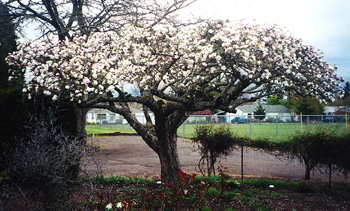IN HONOR OF TREES, THE QUINTESSENTIAL PLANT
by
Chris Maser
Someone's sitting in the shade today because someone planted a tree a long time ago. — Warren Buffet
Some trees are among the oldest and longest living beings on Earth. As such, they represent safety and a sense of eternity and draw us to them, although we are seldom aware of it.

We commune with trees almost unconsciously by bringing them into our lives. We plant them in our gardens and yards and along our city streets for the shade they give in summer's heat. We plant them for their beauty of flower in spring and their color of leaf in autumn. We select them by their shape of leaf and pattern of branch, by their straightness of trunk and texture of bark. The trees we plant are chosen for the contextual dimension their presence adds to our lives as they grace our soulscapes, gardenscapes, cityscapes, and landscapes.
Their presence, particularly that of deciduous trees, demonstrates for us the seasons of the year even as they remind and instruct us about the inner seasons of our lives. Some trees support within their mighty branches the playhouses of the young, while others become the coffins within which rest those departed. Some trees are planted as memorials to deceased loved ones, where their longevity may somehow counterbalance our brevity. And some trees become the houses in which we live and the paper upon which we write. "A stricken tree," wrote author Edna Ferber, "is, next to man, perhaps the most touching of wounded objects."
In areas where wind blows incessantly, such tall, slender trees as the Lombardi poplar are planted in tight rows as windbreaks to protect homes and crops, which may be other trees bearing fruits and nuts for human consumption. Windbreaks are also used to protect topsoil from being blown away. When these trees die, they may be felled for firewood to keep home and hearth cozy against plummeting temperatures ushered in by winter's winds.
And as if that were not enough, we name towns and cities in honor of trees, such as Buttonwillow and Cottonwood, California; Oakville and Pine, Oregon; Cedar City and Elmwood, Utah; and Aspen and Alder, Colorado.
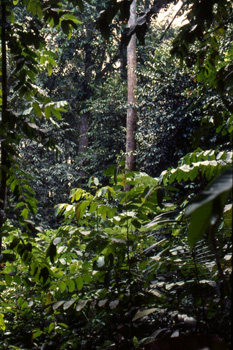
In light of all this, you might well ask what a tree is. If you were to ask me that question directly, I could not answer it. I don't know what a tree is; I only know what a tree is not—it's not a horse, it's not a mountain, it's not lightening; yet it has something in common with all three. A tree, like a horse, is a living being. Like a mountain, a tree is a historian, recording Earth's history in its annual growth rings as a mountain archives cosmic events in its geological strata. And like the electrical soul of lightning, a tree's impulse to live is transmitted throughout its being by electrical current.
But a tree is much more than this, for a tree travels the world in time, its roots growing out of the same soil in which lies the seed of our human heritage. If I followed my ancestral lineage back some 5,000 years, the life span of one bristlecone pine that was cut down at Great Basin National Park in the state of Nevada, I would be looking at the history of 100 generations if the average life span of my ancestors was fifty years or 71 generations if the average life span was seventy years.
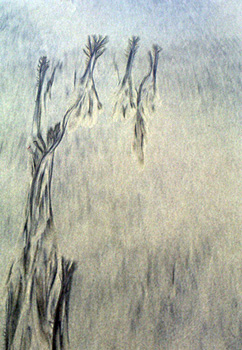
These generations are a bridge across time within the lineage or ancestral tree of a single human family. As such, the shape of a deciduous tree in winter without leaf is a cosmopolitan motif. Consider, for example, the branching behavior of a tree, be it maple, oak, chestnut, elm, or beech.
As a tree moves from Heaven to Earth collecting into branches, consolidating into trunk, and outflowing into roots, it forms a great repetitive dendritic pattern seen everywhere in the waterways of the world. Dendritic comes from the Greek dendron, "tree."
This dendritic pattern appears across the surface of the Earth's landscapes as the arterial system guiding rain and melting snow from mountain and plain to valley and sea. As raindrop and snowflake become trickle, stream, and river, gathering into main stems (trunks) like the Mississippi, the Amazon, and the Nile, they come together in their flowing only to dissipate again over the great deltas where river and sea meet.
Here the waters spread out over the submerged land of the continental shelf and maintain the integrity of their past flowing when the glaciers of ancient times hoarded unto themselves the water and lowered the level of the sea. Today, with the death of the Pleistocene glaciers, these rivers flow in secret, sandwiched between the pulsating sea and the continental shelf, building their deltas, expanding their ever-changing network of channels as each discharges the fresh water of its being into the salty body of the sea.
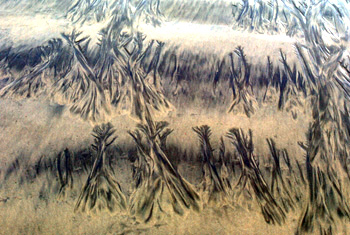
What is hidden by the great body of salt water, however, can be seen in miniature on its sandy shore as the receding tide leaves it musings in the shape of little trees with their collecting branches, uniting trunks, and outflowing roots. This dendritic pattern, which unites land and sea, is sculpted by water under the tutelage of gravity. But not so the tree itself, where its trunk defies gravity's tug and sends skyward its branches to bare leaf, flower, and fruit. The leaves in turn send the sun's energy downward through branch and trunk to feed the hungry roots.
As a cosmopolitan motif, trees represent the spiritual ground out of which the human struggle for consciousness evolves; witness the battle over old-growth trees in the Pacific Northwest or in the tropical rain forest. As the oldest living individual beings on Earth, trees also represent the continuity of life in time and space.
TREES IN TIME AND SPACE
There are in my garden two trees: one pear, the other apple. Along the southern border of my garden, but outside the fence, stand four Norway maples. It is a curious thing, but when I work with them, harvesting fruit in summer, raking leaves in autumn, and pruning branches in winter, I am often struck with awe when I consider what each tree represents in time and space as it stands rooted in the soil through the decades while reaching daily for the sky.
Trees represent for me the flow and ebb of events as they stretch from the present into the distant past. For example, about 55 miles northeast of Las Vegas, Nevada, is the Valley of Fire, a vivid land of bold cliffs amidst the grandeur of the Mojave Desert, where 150 million years ago, during the age of dinosaurs, a forest of primitive evergreen trees called Araucarian pines grew a few miles outside the valley along the edge of a great sea. (The monkey puzzle tree or Chile pine of the western slopes of the Chilean Andes in South America; the Norfolk Island pine of Norfolk Island, east of Australia; and the bunya-bunya of Queensland, Australia, are the best-known living species of the genus Araucaria.)
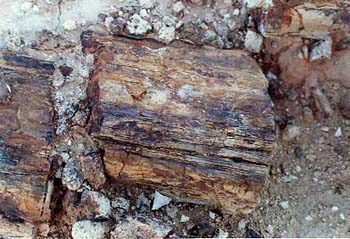
Storms and floods carried branches and whole trunks of these trees into the ancient sea. As trees became waterlogged, they sank to the floor of the sea, where they were buried under hundreds to thousands of feet of mud and sand. Here, in secret, the woody materials were slowly altered molecule by molecule and replaced by silica, quartz, and other minerals until the trees were turned to stone in an almost exact replica of their original design.
Beginning about 140 million years ago, the sea retreated and mud and sand took over and reigned for nearly 75 million years, during which time the valley's limestone was covered to a depth of about 4,500 feet. Carried by winds from the erosion of distant highlands, masses of lofty, shifting dunes—sometimes thousands of feet high—piled up in the valley. Over time, the grains of sand became cemented together with iron to form "fossil" dunes almost a half-mile thick.

Then, about 100 million years ago, as the seafloor plate that lay beneath the Pacific Ocean to the west of the North American continent moved directly against the continent, the heavy oceanic plate was forced below North America. It created titanic forces as it crashed against North America in its resistance to being pushed under the continent. As the seafloor plate moved beneath the continental plate, it melted and injected its lighter weight components upward into the continent.
The Sierra Nevada Mountains of California thus began to form as gigantic intrusions of molten rock forced their way up into the Earth's crust, shoving aside the existing continental rock. The rise of the Sierra Nevada Mountains not only began to trap moisture on the mountains' western slopes, which caused the region east of the mountains to become increasingly arid, but also closed southern Nevada's outlet to the sea some 25 million years ago. Since then, erosion has been the dominant geological activity in the valley.
Today, the grains of sand released from their millennial bondage once again blow across the desert. And here and there scattered about the desert is the multicolored petrified wood, including whole trunks, of the Araucarian pines whose inner spaces have been formed over the millennia into little troves of minute crystals that now dazzle the eye as they lie sparkling in the sun, where they rest among other rocks whose rough gray bodies guard fossil seashells, corals, sponges, and sea lilies from the time when the valley was a warm and watery world teeming with life.
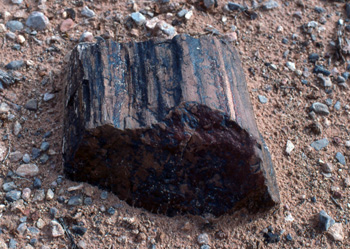
Not all ancient trees are fossils, however. In August of 1994, David Noble, the Parks and Wildlife Service officer in Wollemi National Park in the Blue Mountains near Sydney, Australia, walked into a damp, protected gorge in the park. As he did so, he stepped into a tiny one-acre grove of Jurassic-age pines thought to have been extinct these last 150 million years. Although the Wollemi Pines, as they have been dubbed, once covered vast areas of the world, they were thought to have succumbed to changing climate—that is, all but the 39 individuals now known to be still living. The grove consists of 23 adult trees and sixteen juveniles, making the Wollemi pine one of the rarest plants in the world.
Its foliage is dense and waxy, and its knobby brown bark gives it the appearance of being coated in bubbly chocolate. The largest tree towers 130 feet into the air and has a ten-foot girth, indicating that it may be at least 150 years old.
Ironically, "wollemi" is an Australian aboriginal word meaning "look around you," which points to the notion that we do not know our own planet very well when such a large tree can go undiscovered for so long in, of all places, an established national park. As such, "wollemi" has encompassed within its symbolism the wonder of these trees that for so long have been enshrouded in the Eternal Mystery. Think for just a moment of the Wollemi pine's incredible journey through the all but trackless sands of time, over 150 million years, the last two centuries or so under the very nose of learned society.
Unfortunately, many people define the things in their environment by their ability to convert them into money, and that includes the newly discovered Wollemi pine. Of the forty seeds that were taken from the grove, one has germinated. Now the Mount Annan Botanic Garden is hoping to become rich by propagating them. "Let's face it," says Mark Savio, curator of the gardens, "everyone is going to want one of these plants from the age of the dinosaurs."
How can something so ancient in lineage, so venerated in age, so magnificent in structure and function, and so awesome in stature as a mature Wollemi pine, or any number of other trees, be reduced solely to an intellectual definition or a quantifiable monetary value? To me, no tree can be so treated, for trees connect the generations of life not only in time as the oldest beings on Earth but also in space as they travel around the oceans of the world.
Drifting trees, either individually or as wood islands, ferry communities of plants and animals from one geographical location to another, as they are carried hither and yon by ocean currents and trade winds. In the North Pacific, for example, drifting trees that escape the inshore oscillations of the tidal currents enter the open ocean, where they may eventually contact the westward transport of the North Pacific gyre, a great circular vortex.

Some drifting trees become waterlogged and sink once they become entrained in the North Pacific vortex. Such trees become islands of food for deep-sea wood-dependent organisms on the floor of the ocean. Other large drifting trees, however, remain afloat for long periods and great distances to come ashore in such exotic places as the Hawaiian Islands, where in fact trees from the Pacific Northwest account for most of the large driftwood on the beaches. Other drifted trees on the beaches of the Hawaiian Islands are indigenous to the Philippines, Japan, or Malaysia.
Anthropological records show that the beached Douglas-fir, western red cedar, and coast redwood were even integrated into the customs and rituals of oceanic cultures. Ancient Hawaiians prized these huge trees washed up on their shores because local chiefs preferred them for construction of their large double canoes, a symbol of wealth and power.
Iceland provides another example of traveling trees. According to geologist Sir Charles Lyell, Iceland's ancient forests had already been "improvidently exhausted" by the mid-1800s:
…although the Icelander can obtain no timber from the land, he is supplied with it abundantly by the ocean. An immense quantity of thick trunks of pines, firs, and other trees�is thrown upon the northern coast of the island … [sufficient] … for fuel and for constructing boats. The timber is also carried to the shores of Labrador [the mainland part of Newfoundland, Canada] and Greenland; and Crantz assures us that the masses of floating wood thrown by the waves upon the island of John de Mayen often equal the whole of that island in extent. [John de Mayen is now called 'Jan Mayen' and is a fairly large island of Norwegian ownership lying north northeast of Iceland and east of Greenland.] In a similar manner the bays of Spitzbergen [a Norwegian archipelago in the Arctic Ocean between Greenland and Franz Josef Land] are filled with drift-wood … consisting of larch trees, pines, Siberian cedars, firs, and Pernambuco and Campeachy [sic] woods [trees from Pernambuco, a state in northeastern Brazil, and the Campeache or longwood tree, a species indigenous to tropical America and the West Indies].
Considering trees in time and space makes it impossible for me to reduce a tree to a mere intellectual abstraction. I shall therefore endeavor to paint for you a word portrait of a tree in but a few of its myriad forms. To paint such a portrait, it is necessary to examine the leaves, flowers and fruits, branches, trunk, and roots.
Although I discuss the parts of a tree as separate components, remember that a tree is a living being, an integrated living system in constant motion, and as such is surrounded by and infused in a large system called the biosphere, which includes you and me. This being the case, I shall discuss the tree within the context of itself, beginning with the leaves and progressing to the roots, so that you may gain a small measure of how trees as species enrich the world.
LEAVES
With the advent of each spring, there comes forth a soft green halo on the trees of my garden as the sleeping leaves of winter awaken and grow. I love the leaves of spring, for they are bright and tender with the innocence of a new year. With the passing days, however, the leaves mature in the warmth of the sun and become home and food to insects. And it is while watching a wee caterpillar climb a leaf on my pear tree that I find myself contemplating what a leaf really is.
Leaves come in limitless sizes and shapes, no two of them ever exactly alike. They have many functions, be they the broad leaves of a maple, the needles of a noble fir, or the small leaves and long thorns of a desert acacia. They are, for example, amazingly compact energy converters, which use chlorophyll to harness the sun's energy, to convert carbon dioxide, water, and elemental nutrients from the soil into simple sugars that are in one form or another distributed throughout and among ecosystems, where they are a critical part of the world's food web.
Leaves also transpire water, creating a humid microclimate around their individual surfaces within a tree's crown and within a forest. As they filter the sun's light passing through their bodies, the leaf community of a tree's top creates an ever-moving dapple of lights and shadows on the forest floor in response to the sun's daily passage across the heavens.
A forest spider can find shade from the sun and a roof from the rain under a single leaf. Although considerably larger than a spider, some tropical bats chew partway through certain leaves, causing them to fold over and create an instant shelter in which the bats pass the daylight hours sleeping.

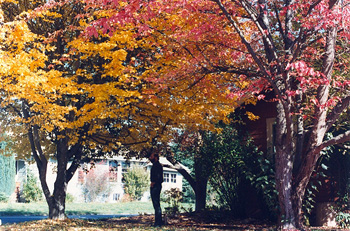
As far as we humans are concerned, however, it takes the combined shadows of many leaves to cast one large enough to protect us from the sun's heat and ultraviolet rays. But in the distant Congo where the Pygmies live, there are leaves large enough for these small forest folk to thatch their simple huts with roofs of green.
And leaves create beauty not only in form and function as they grow and mature in spring and summer but also in color as they change hue with their dying in autumn. For it is autumn's warm days and crisp, clear nights that begin calling the leaves back to earth to share the atoms they have so briefly borrowed from the atomic interchange of the ages. As autumn matures and the winds blow colder and harder, the dying leaves break loose their bonds to bump and bounce and float to earth. Others, clinging stubbornly to dormant twigs, rustle in the teasing wind. Each passing day sees more leaves collect beneath trees, forming a brittle, crunchy blanket over the ground.
It is in autumn that I get out my rake and begin collecting the falling leaves of the pear and apple trees in my garden and of the maples just outside the fence. No matter how often I rake under the trees, each warm, blustery, southwesterly wind off the Pacific Ocean and each cold, north wind from the Alaskan and Canadian arctic sends more leaves scurrying across the ground I have just cleared. Be that as it may, each time I rake the leaves into piles, I am reminded of my youth.
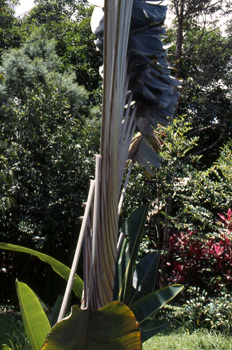
Autumn was the time in my youth when the fallen leaves of oak and maple were raked by hand into long rows on the golf course next to where I lived. The rows of leaves were collected into a trailer pulled behind an old Ford tractor and taken to the traditional burning area, which just happened to be near my house. And it was here in the autumns of the past that I discovered the pure joy of jumping into mammoth piles of leaves and of throwing them into the air and having them rain down around me. As Indian summer drew to a close, however, my leaf-jumping season ended, for this was the time when the leaf mountains were lighted to smolder for days with tiny red, orange, and yellow flames writhing hither and yon in a tortured dance amidst the billowing greenish-gray smoke until all that remained were great piles of ashes.
And then comes winter, the season of leafless trees and bare-limbed shrubs, of withered bygone flowers and dead grasses. It is a time for hibernating, for being snug and sleepy in a cozy nest as wind-driven rain and sleet and snow buffet the outside world. What about the leaves of spring and summer? Where are they?
Have you ever looked closely at a leaf bud on a tree in winter? Inside the frozen bud is a miniature leaf just waiting for spring to release it from bondage to begin again the dance of leaves exemplified by the trembling ballet of quaking aspen as they rustle softly in summer's breezes.
Unlike the leaves of maple and oak, of beech and ash, the needles of coniferous trees do not dance in the breezes, for they tend to be narrow and stiff, designed with the rigidity of soldiers clinging to limb and twig in orderly file. Although they do not dance, they sing. And to me, the greatest love song of all time is the wind playing its melody through the orchestra of needles high in the crowns of ponderosa pine. Although the needles of coast redwood trees do not sing like those of pine, they collect precious water.
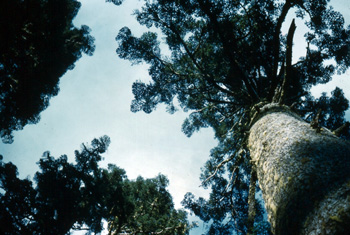
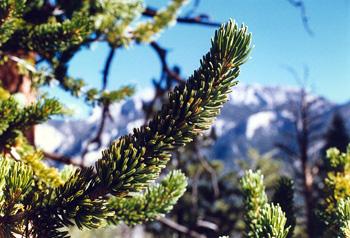
The great redwood forest of northwestern California would not exist if not for the coastal fogs. Most of the redwoods' summer moisture is gleaned from fog flowing inland from the Pacific Ocean, where it collects on needle after needle. Here it forms into crystalline mounds that converge into fluid pendants that drip with the persistence of Chinese water torture from lofty crowns to saturate the forest floor, where salamanders depend on it for the breath of life because they absorb oxygen through their skin and must therefore remain moist or they suffocate. Beyond the salamanders, deeper in the soil, wait the thirsty roots of the giant trees that for millennia have gathered their own drinking water along the edge of the sea.
To the north, in western Oregon, lives the small red tree vole, mentioned earlier, a mouse-like denizen of the stately Douglas-firs. Building its nest anywhere from six to 150 feet above the ground, it depends for life on the needles of Douglas-fir and along the coast on western hemlock and Sitka spruce. In addition to eating the needles, however, these little tree-dwelling mammals lick the dew off of them and thus quench their thirst. Their ability to use this source of water allows them to extend their geographical distribution eastward into the hot interior of the land along major rivers, which create their own fog that in turn envelops the Douglas-firs growing along their banks to the benefit of these small voles.
Halfway around the world, in the deserts of Egypt, grow acacia trees whose tiny leaves and rapier-like thorns conserve precious moisture as they endure the scorching heat of a relentless sun, the hot breath of desert winds, and the choking clutch of howling sand storms. Yet even here, the leaves must produce the essential sugars from the sun's harvested light if they are to live.
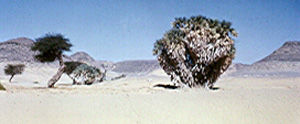
Here, too, lives the shrike or "butcherbird." The butcherbird is so called for its habit of fastening extra food securely to the acacia's thorns by impaling its prey thereon for another day's feast. Thus a thorn, which on some plants is an anatomically modified leaf in Nature's scheme of things, not only conserves moisture and protects its bearer from being eaten by most large herbivores but also serves as a pantry for so deft a hunter as the shrike.
I also remember finding a mummified hawk in the top of a date palm at Kurkur Oasis in the desert west of Aswan, Egypt, on Christmas Day in 1963. On retrieving the bird, which was in a diving position or "stoop," I discovered that it had pierced itself to death on the single blade of one of the palm's fronds and became an instant mystery riveted in time and space.
Clearly, it had been in its eternal dive a long time for its feathers of brown were severely faded. But how long? What had the hawk been so intent on capturing that in its singular focus it had run itself entirely through?
The irony is that the palm frond, which may have shaded the hawk one day from the sun's searing heat and glaring reflection off the desert sand, had the next taken its life. How long would the hawk have remained skewered, bleaching in the sun, had I not happened on the scene to bear witness to one of life's many unexpected twists?
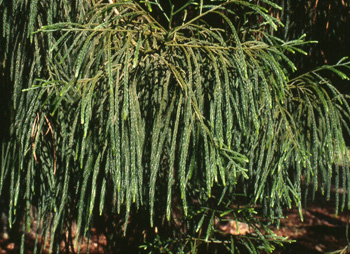
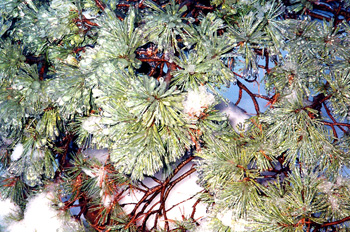
Unlike deciduous trees, which lose their leaves seasonally and stand in naked slumber for part of each year, such conifers as Douglas-fir and western hemlock shed about a third of their needles annually. As the needles die and turn yellowish, they loosen from their moorings and spin quietly to the forest floor or ride the gusty winds to their final resting place. There, they serve as food for a host of organisms and thus through many circuitous routes are eventually incorporated into the forest soil only to rise again in some future microbe, flower, mouse, or tree, each of which in turn completes its cycle and passes on the atoms it borrowed from needle and leaf.
Thus, while a deciduous tree or forest annually produces two entirely different habitats, one in full leaf and another following leaf fall, a coniferous tree or forest produces a continuous habitat of relatively similar characteristics throughout the year. In addition, broad leaves decompose rapidly and pass into the soil within a year, which makes them ideal mulch and compost for my garden, whereas coniferous needles may take a decade or more to break down and recycle through the system.

The length of time a leaf adheres to its tree is important to the leaf miners, which are any of a number of insect larvae that live in the thin layer of cells sandwiched between the opposing outer surfaces of leaves. To survive, they must time their life cycles to coincide with those of the leaves in which they dwell.
A leaf miner hollows out its path from egg to adult as it eats its way through the interior of a leaf. The hollowness of the tunnel grows in a width commensurate with the growth of the larva. But a leaf whose internal structure has been weakened by a miner cannot, I have learned, produce the quality of sound needed to be a musical instrument. To be true in melody, a leaf must be structurally sound and carefully chosen.
In May 1967, while taking a rest on the climb to my field camp at the 11,500-foot level on the mountain known as Phulung Ghyang, in Newakot District of Nepal, I watched one of my Tamang porters, a woman, search a small tree with oval leaves three to four inches long, examining leaf after leaf. Finally, with a look of absolute serenity, she selected one. Walking to a medium-sized boulder along the edge of the trail overlooking the vast emptiness of space as it plunged thousands of feet into the valley below, she climbed upon the rock and faced outward into the void.
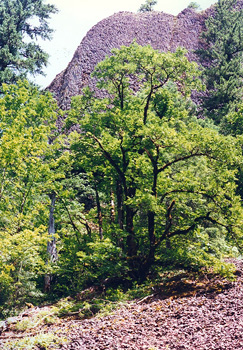
Holding the leaf horizontally with one hand on each side of her mouth, she blew on its edge, and there came forth the most exquisite melody I have ever heard in my life. The liquid notes of a winter wren or a meadowlark are no match for the mystical quality of the music I heard that day so long ago. In that instant, the woman and the leaf became one, and from their union was born the most intricate, the most delicate praise of life I have ever experienced, or probably ever will experience in my earthly pilgrimage. The soul of all humanity, from its earliest dawning, was called forth to rejoice in the perfection of woman, leaf, music, and the Eternal Mystery that created them all.
From that day into forever, a tree's leaf will for me always be a symbol of the human spirit, perhaps in a way similar to the emblem of the maple leaf on the Canadian flag that represents Canada's national spirit.
However one looks at leaves, they are a graphic symbol of life's cycle, from their emergence in spring, through their maturation in summer, to their decline and death in autumn, and their apparent absence in winter. But the leaves of trees are more than that. They are also a barometer of the harmony with which human society coexists within its environment, for they simultaneously produce the oxygen we breathe and monitor our trusteeship of the world's air, soil, and water, which affect the tree's flowers and fruits in my garden as well as in the forests of the world.
FLOWERS AND FRUITS
The creation of a thousand forests is in one acorn. — Ralph Waldo Emerson I find in every plant's seed the miracle of its being, because each seed has already present, hidden within its coat, not only the size and shape of the tree but also the size, shape, color, odor, and season of bloom of its flowers, as well as the size, shape, color, odor, flavor, and season of maturation of its fruits. Thus, the pear tree in my garden looks like a pear tree and produces only pear blossoms and fruits, and the apple tree likewise produces after its kind, as do the maples. Like all other components of life, there is infinite variety in flowers and fruits.
Some flowers are bright and showy, some drab and secretive; some are large while others are tiny; some transmit from place to place wonderful perfume on the pathways of the air, and others do not. Some flowers are pollinated by wind, some by insects, others by birds and bats. Brightly colored flowers always cheer me, regardless of circumstances. And some flowers scent the air in such a way that on smelling them I am transported to another world.
Some trees have both male and female flowers on the same individual plant, whereas others have them on separate plants. Some flowers contain both male and female parts in the same blossom; others have separate blossoms. Some flowers are self-fertilizing when cross-pollination fails, whereas other flowers accept pollinated only from different blossoms.
In addition, some male flowers, through their wind-borne pollen, have left a multi-millennial climatic record and through it given society a glimpse into its own evolution before language made recorded history possible. The time-encapsulated secrets of a world lay archived in the sedimentary strata of lake bottoms, peat bogs, and glaciers before humans even knew how to question their existence. Here is secreted the drama of migrating trees and forests, of great fires and raging floods, of glaciers and drought-ridden deserts. Here, too, resides the ancestral lineage of communities of trees whose pollen chronicled their comings and goings even as their blooms brightened the day with color and tinted the air with odor in their bid to bring forth fruit and seed—the trees of the future.
But most of all, I marvel that so small a cone, so tiny a seed as that of the western red cedar can produce the ancient trees I remember from my youth, when a fallen monarch was so big that I could not climb over it when it blocked the trail as I hiked along the Green River in western Washington State. And the coastal redwoods of northwestern California live even longer and grow larger than the cedar.
The first time I saw a redwood tree, I pressed my cheek against its bark in an effort to look up the straightness of its trunk to the place where its top and the sky met. I failed, however, because the tip of the redwood's crown was far loftier than I had ever imagined. While I was awed by the sheer size and majesty of this ancient tree, I was comforted by it as well. This redwood, close to 3,000 years old, also arose, like the cedar, from a seed so fragile that I could squash the life out of it between my fingers.
As flowers provide food for such animals as honeybees, butterflies, hummingbirds, sunbirds and nectar-eating bats; fruits, seeds, and nuts offer food to others, such as squirrels, mice, deer, bear, and fruit bats, some of which have wingspans approaching four feet. The flowers and fruits eaten by animals are not, however, free of service to Nature.
Many species of trees in the tropical rain forests, especially those that germinate in the dark understory, have large seeds that carry enough stored energy to grow leaves and roots without much help from the sun. Such fruits and seeds are often so large that only proportionately sized birds and mammals can swallow or carry them. In Gabon, a republic of west-central Africa, for example, monkeys may disperse 67 percent of the fruits eaten by animals.
Seed-dispersing animals, such as large birds and monkeys, are critical in replacing the large trees and lianas (high-climbing vines) of the tropical forest canopy. By eating the fruits and defecating the seeds some distance from the parent plants, thereby improving the seeds' chances of landing in a favorable place for germination, the birds and monkeys are helping the trees and lianas, as species, to survive. These animals are the first species to disappear, however, when humans hunt for food and, along with elephants, have already been hunted so heavily that they either have been drastically reduced in numbers or eliminated completely over vast areas of the African forest, as well as in the tropical rain forests of Central and South America.
For the most part, foresters have overlooked how the interdependency of plants and animals affects the biodiversity of a plant community. Elephants, for example, disperse the seeds of 37 species of trees in the Ivory Coast, a republic of western Africa. Of those, only seven species have alternate means of dispersal (by birds and monkeys). Of the 201 individual trees in one study area, elephants dispersed 83 species. In one forest, where humans had eliminated elephants a century earlier, few juvenile trees of the elephant-dispersed species were left, and the two major species had no offspring at all.
Once the large species of birds and mammals are gone, the stunningly rich tropical rain forests will change and gradually lose species of trees, lianas, and other plants. Smaller seeds dispersed by wind will replace large seeds dispersed by large animals. Those species of plants whose seeds grow in the shaded understory will not survive, and the land will gradually be forested by fewer, more common species.
A similar, albeit simpler, phenomenon is taking place in my own garden with scrub jays. Each autumn, the jays bury hazelnuts, filberts (also a nut), and acorns and simply leave them over winter, forgetting where they are. But the jays are back in late spring and early summer searching for seedlings that germinated from their autumn caches. On finding a seedling, a jay digs down to the filbert or acorn, plucks it from the seedling, cracks it open, eats the remains, and flies away. The seedling, meanwhile, is well established and flourishes—until I pluck it out.
Some animal-fruit interactions, however, appear to have little or nothing to do with seed propagation. In mid-February 1972, I was in the canyon along the Crooked River near the town of Prineville in central Oregon. It was a clear, warm, sunny day. The ground was mottled with snow. A light breeze, blowing up the Crooked River, carried with it ever so faint a hint of spring. As I glanced toward the river, I saw a muskrat climb out of the water and search the bank for something to eat. Somewhere a Canadian goose called, then another. It was peaceful with the little sucking noises of the water against the banks and the voices of the animals.
What a perfect day! I was protected from the wind by juniper trees growing along the river and up the slopes to the massive rims of basalt, which capped the canyon's walls. And just across the river, I could see more junipers marching out of sight into the distance. As I stood breathing deeply of the cold, clean winter air, I glanced toward the rim of the canyon, where part way up the slope was an incredible commotion. Birds were plummeting out of the trees for no apparent reason. My curiosity aroused, I found a place to cross the river and started up the slope.
It is common in this country for birds of different species to band together in winter, forming what is called a feeding flock. As I climbed toward the rim, the commotion, which until then had been silent with distance, became an awful din. Mountain bluebirds, evening grosbeaks, cedar waxwings, and robins, with a few birds of other species thrown in, were creating incredible pandemonium. There were hundreds of them, all seeming to squawk at once. In addition, I could see, even from a distance, that some of them were literally falling out of the trees and flopping around on the ground with their heads lolling this way and that, unable to fly. What on earth was going on?
I began walking a little faster, for it was now obvious that something was seriously amiss. I had seen birds act in a similar manner in years past when pesticides had been sprayed in an area. But who would be spraying pesticides in this isolated canyon country at this time of year, and what would they be spraying for? It just didn't make sense.
I was still some distance from the birds, and slightly out of breath from my rapid climb, when I became conscious of just how sweet the juniper berries were that I had been plucking off the trees as I walked by. They had an unmistakable zing to them--the berries were fermenting because they had been frozen and warmed again by the sun only to be refrozen and warmed again.
I suddenly understood, and all I could do was laugh until my stomach and sides ached. The birds were drunk, very drunk, but dangerous mostly to themselves. They were just crashing into things, and once down, they simply could not get up again. No matter what they did, they could not become airborne. And there were hundreds of them, all in various stages of inebriation.
If birds get hangovers, I mused, there would be a bunch of miserable birds in the days ahead. Just then, a bluebird fell off a branch. Well, I thought, if they don't get hangovers, they must certainly get bruises.
BRANCHES
The leaves, flowers, and fruits of a tree are simultaneously nurtured, held for a time securely in place, united, and ultimately allowed to fall from branches. January and February are the months each year during which I must attend to the branches of my fruit trees and, if necessary, those of the maples. It is the time of year when the sleeping trees are ready for pruning, when last year's growth is cut and the trees shaped to keep them under a semblance of control.
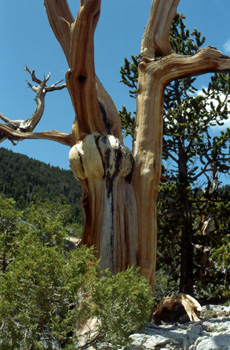
When Zane, my wife, and I bought our house, the pear and apple trees were unkempt and in need of attention. Arriving at our new home in late summer, our first harvest needed to be done by climbing into the trees to reach those fruits whose locations were beyond the capacity of my ladder. But over the next three years, I pruned the branches shorter and shorter each winter, and I can now reach almost every pear and apple from a six-foot stepladder.
It is during the activity of pruning that each year I revisit the concept of a branch and how humanity has endowed this portion of a tree with a variety of symbolic meanings. Branches, for example, are like the arms of a tree, the shape of which often conjures its human-envisioned demeanor—a gnarled oak, a weeping willow, or a stately ash.

Beyond space, in the realm of time and human imagination, a tree offers a symbol of Creation and the balance between the spiritual (branch) and material (root) aspects of life in the "tree of life," of the continuing evolution of life's infinite variety in the branching of the "phylogenetic tree," and of the continuity and divergence of personal lineage in the branching of the "family tree."
But what does a spider whose sole intent is to fasten its web from branch to branch or a warbler seeking a suitable location for its nest know of time or human imaginings. To the spider, one branch may be much like another as an anchor for its web, but to the nesting bird or sleeping bat, branches are as varied as the trees themselves.
A Douglas-fir, for example, offers many suitable nesting sites for a variety of birds among it horizontal branches and abundant, stiff needles and a secure place the hoary bat to hang by day; but a western red cedar or Alaska yellow cedar, with its drooping branches and tiny scale-like leaves, has little that a nesting bird or sleepy bat requires. The same is true of a Pacific yew with its zigzagging branches and often scraggly form, of a western hemlock whose branches are sparsely clothed in lacy needles, or of a tamarack, whose branches are covered with little pegs to which are attached whorls of soft, pliable needles offering little protection from sun, wind, or rain.
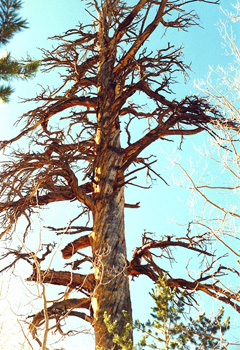
But the same limber, downward sweeping branches that are unsuitable for a nesting bird, such as those of a grand fir, can shelter a snowshoe hare. A grand fir's boughs with their flat needles often become weighted down and frozen into snow as it continually piles up around the fir's base during a long mountain winter. In the cavity created and maintained under the fir's bough as it becomes roofed over by snow, a hare is safe and warm, out of the bitter cold wind.
As a boy, I thought branches were made for climbing. But even then, I discerned that there were safe and unsafe branches and that some trees, because of the characteristics of their branches, were easier to climb than others. I learned to "read" a tree's branches, taking none for granted before placing my weight on them or using them to pull myself upward.
Some branches, such as those of the hawthorn, locust, or acacia, are not readily climbable because of their thorns. Some branches, such as those of the South American monkey-puzzle tree, are protected by sharp, scaly leaves, which can confound even a monkey. Others, like beech, are smooth and difficult to grasp. Spruce branches are covered by tiny, rough "pegs;" whereas rhododendron branches at the timberline on Phulung Ghyang, Newakot District, Nepal, have exfoliating bark, which is continually self-peeling. And the branches of the true fir, which grow between 11,000 and 12,000 feet on the same mountain, are strong enough to give the common langur, a large monkey, safe purchase for a good night's sleep because they are simultaneously too limber to support the weight of the heavier clouded leopard, which hunts the monkeys at night for food. But whatever a branch is like, it is somehow synonymous with campfires.
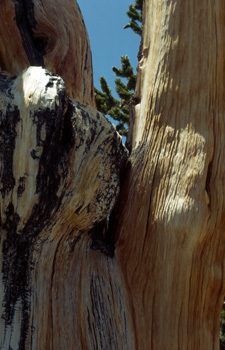
Fire was my only constant companion in years bygone, as it was that of my boyhood heroes, the American Indian and the mountain man. My first fire was intensely spiritual and private, known only to me and to the silent forest. The wisp of fir smoke, the heat, the tiny licking flame, the crackling branches became part of my spirit—and still are.
Since the days of my youth, fire has warmed me during cold winter nights in interior Alaska and during chilly desert nights in North Africa. Fire has cooked my food in the jungle of northern India and in the Himalayas of Nepal. And it has lifted my spirit on days of seemingly endless rain and shrouding fog in the coastal mountains of western Oregon and Washington.
Each fire is a reflection of the past, of the dawn of humanity, when the first purposefully made fire united humans and branches in a cultural dance the world over, a dance to remove the darkness and its terror, to heat a protective shelter, to cook food, and to alter the landscape for hunting, gathering, agriculture, and war.
Then again, the notion of a branch or branching has found its way through language into our culture. We say, for example, that we are going to open a branch office or that we are branching out into other things. In this sense, a branch is seen as moving away from the trunk, from the collective, to broach the unknown, which is the very essence of the Creative Principle, exploration, and personal growth.
These are some of the things I think about each winter as I prune the fruit trees in my garden. Why do I think about these things? I focus on them because the health of a tree's crown determines in large measure the health of its trunk, which is a great conduit of flowing energy that unites Heaven and Earth through the living being of a tree. And I want to keep my fruit trees and maple trees healthy, and myself along with them.
TRUNK
Although there is nothing that I must do with the trunks of the trees in my garden or with those of the maples just outside, except be careful not to injure them, I am reminded while pruning the branches each year that it is the trunk of a tree that has in so many ways influenced humankind. The trunk, in this sense, is the main ascending axis of a tree, a stalk or stem. To me, however, a tree's trunk has always been more than simply the stem of a plant, especially one trunk, that of a giant noble fir on Marys Peak, the highest mountain in the Coast Range of western Oregon, whose campground near the summit is only 25 miles from my hometown of Corvallis.
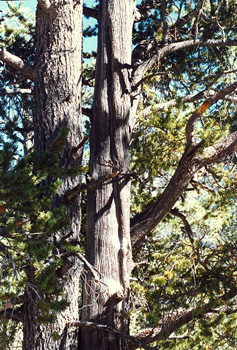
The campground was at the end of a narrow gravel road that made a short loop through blue-tinted grandparent noble firs that ringed the lower edge of the grassy meadow atop the peak. And it was here, near the last picnic table at the meadow's edge, that in 1943 at age four I discovered the huge trunk of a fallen noble fir.
The trunk, which had already lain on the ground for some decades, was so large that I had a difficult time climbing on top of it. Nevertheless, I never got enough of climbing on it, exploring its nooks and crannies and examining the mosses, lichens, mushrooms, and various insects and centipedes that lived in, on, and around it. And sometimes, if I managed to lie quiet long enough, a squirrel or Townsend chipmunk would scamper over the top of me as though I was part of the trunk.
I visited the old trunk as the years passed. While I matured in stature, the old trunk became smaller and smaller as it gradually rotted away, returning to the soil from whence it had grown in times before my birth, when it had stood for centuries as a sentinel along the edge of the ancient, powdery-blue forest. In the summer of 1964, when I was 25 years old, I visited the old trunk, sat on it while enjoying the warmth of the sun, and stepped over the top of it as though it were now the child.
I felt sadness in so doing, however, because the old trunk, now mostly collapsed in on itself, had given me as a child a measure of stability that I could not find in my family. As a child, I could talk to it, confide in it, and be safe with it. I wonder if the sadness I felt was in part a premonition that this was to be my last visit to the old trunk. In any case, it was; a severe early-winter storm blew down that whole portion of the forest and the old trunk all but disappeared under the impact of neighboring trees as they fell on it.
Thinking back to the trunk of that ancient noble fir, I wonder how the first humans might have begun a purposeful relationship with the trunks of trees. Was it the discovery of hollow trunks as shelter or drums? Was it the leaping flames, far-flung light, and long-lasting heat of a trunk burning? Or was it when the first human hollowed a tree's trunk with fire and the canoe was born, and so might have begun the purposeful exploration of the world's waterways?

Consider that without the large trunks of trees, there would have been no cedar bark from which indigenous peoples of the north Pacific coast of North America could make their waterproof capes and hats, no birch bark from which indigenous peoples of northern and eastern Canada could make bowls and canoes, no cork from the cork oak with which to seal bottles of vintage wine, no tannin from the tan oak with which to prepare leather, and no taxol from the Pacific yew with which to treat or cure breast or ovarian cancer in women.
Without the large trunks of trees, there would have been no wood for drums, wheels, ox yokes, houses, ships of olden days, or the first airplanes. And what about one of humanity's greatest triumphs, music?
Over the centuries, music has been committed to paper by great composers and translated into sound through orchestras. An orchestra, in turn, is composed of musical instruments and musicians that together give voice to the mute beauty on paper. A musician's ability to play a musical instrument is dependent not only on human skill but also on the quality of the instrument.
Over the last two centuries, the violins made by Antonio Stradivari (1644-1737) have given to the human ear some of the world's most exquisite melodies. To build a violin of the quality of a Stradivarius, however, one must not only be an expert violinmaker but also have available fine-grained wood from the trunk of an ancient tree, such as a Sitka spruce.
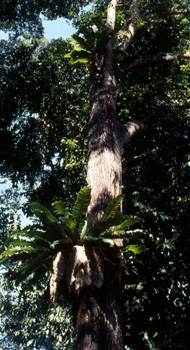
Without trees, the peoples of the great continents would still be separated from one another; the oceanic islands, such as Hawaii, New Zealand, and Australia, would be barren of people; and the oceans and the skies of the world would still be unknown. The world and human culture would be very different without the sounds of the Stradivarius and all other musical instruments crafted from the trunks of trees. Without heat from wood, there could be no metal, and the face of the moon would still be without the footprints of humanity. And I, as a boy, would not have had my ancient old -fir to climb on windy days, where near its top, reveling in its supple strength, I could ride with the wind as it blew the ancient tree hither and yon.
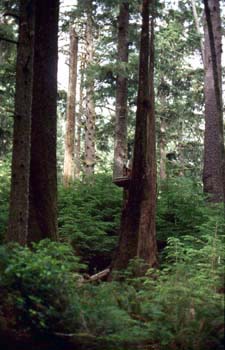
But the influence of a tree's trunk reaches far beyond human history into the eons of life's web as it grows, matures, declines, dies, falls, and recycles into the soil. An old -fir tree in its 810th year dies in the mountains of western Oregon and falls to the floor of the forest. For 525 years, the forest grows up around the decomposing giant until its last vestige is incorporated into the soil. Over the decades and centuries, the tree's atoms become parts of bacteria, fungi, earthworms, insects, birds, mammals, and green plants as each in turn has borrowed, used, and given up the atoms of its being to the next in line. Some atoms may go from insect to mother bird, to her offspring and be carried away on wings and wind to a distant land, there to enter a different strand in life's web.
Suppose, for instance, that a young warbler matures and dies while over-wintering in South America, where it falls into a jungle stream and is eaten by a scavenging fish. The fish is caught by the son of a poor slash-and-burn farmer, who builds a small fire and cooks and eats the fish. A year later, the boy leaves the jungle and goes into a city to attend school. After some years of wandering, he goes to sea as a merchant seaman and dies an old man on a far distant shore where the atom of the ancient tree that became part of the insect that became part of the warbler that became part of the fish that became part of the boy now enters yet another stand of life's web.
Thus from seed to soil, the old fir's trunk influenced the site on which it grew and fell for 1,335 years, but its atoms will travel the world forever. As I mentioned earlier, I know of a bristlecone pine in Great Basin National Park that was finally cut down at an age of more than 5,000 years. How long would its trunk have influenced the site on which it grew had it been allowed to fulfill its entire ecological role? Where might its atoms travel could we but follow them through the corridors of time—to the root of another tree?
Speaking of roots, one of the maples just outside my fence has at least one root close enough to the surface of the ground under the concrete walk alongside my house that is large enough to both split the walk and elevate part of it at least an inch. Such is the power of roots.
ROOTS
Unlike the crowns of my pear and apple trees or those of the maples, which periodically require my attention during any given year, none of the trees' roots make such demands. Although there is nothing I need do directly to or with the roots in the sense of gardening, I must understand something about their relationship to both the soil and the aboveground portion of the trees they support, lest I inadvertently compact the soil and thereby hinder their ability to function.
As a tree's leaves caress the sky and harvest momentarily the sun's energy, so its roots are fastened in the Earth, where they grip the soil while harvesting the sun's energy stored in darkness from millennia past. The soil, where nonliving and living components of the landscape join, is also where past and present flow one into the other and determine a tree's future.
Soil supports the plants and animals that in turn create and maintain the myriad hidden processes that translate into soil productivity. Into this incredibly thin band of seething activity, the very ferment of terrestrial life, a tree thrusts its roots that it may withdraw energy long stored in Nature's warehouse and replace energy derived from the present net worth of its photosynthetic exchange, the leaves of its crown.
But here one might ask, "What is a root?" Most people probably think of a root as the underground portion of a plant that serves as support, draws food and water from the surrounding soil, and stores food, all the while holding the soil together. A root is far more than this simple description, however.
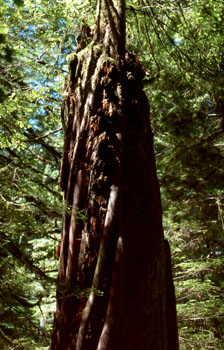
To examine the notion of a root, we will venture into a largely unknown, hidden world with the slightly buried seed of a Douglas-fir as our guide. It is spring and the seed begins to swell as it absorbs moisture from the warm soil. The seed's coat splits, and a tiny root begins to penetrate the bosom of the Earth as small, green seed leaves reach toward the sun. Thus the seed of the tree becomes the seedling of the tree in its first spring of life.
As the seedling's roots spread through the soil, the new nonwoody root tip of a tiny feeder root comes in contact with a week-old fecal pellet of a deer mouse. The deer mouse had dined on a truffle (the belowground fruiting body of a fungus) the night before it deposited the pellet. The pellet, packed full of the truffle's spores, is still soft from the moisture in the soil, and the root tip has little difficulty penetrating it.
Inside the pellet, the root tip comes in contact with the spores that have passed unscathed through the mouse's intestinal tract. Meanwhile, the yeast (a fungus) in the pellet is growing and producing a substance called yeast extract that is food for the nitrogen-fixing bacteria. ("Nitrogen fixing" means to capture gaseous nitrogen and convert it into a form usable by the plant.) As the root tip contacts the spores, the yeast helps stimulate the spores to germinate and grow into and around the root tip; the nitrogen-fixing bacteria and yeast become enveloped in the fungal tissues. Once inside the fungal tissue and in the absence of oxygen, the nitrogen-fixing bacteria are nurtured by the extracts of both the yeast and the truffle's non-reproductive tissue. The bacteria in turn fix atmospheric nitrogen that can be used by both the fungi and the host tree.
The non-reproductive tissue of the truffle, called mycelia, forms a mantle around the tree's feeder root; this symbiotic association is called mycorrhiza, which literally means, "fungus-root." As the mycelia grow into and around the root tips, they also grow out into the soil where they join billions of miles of gossamer threads from other mycorrhiza-forming fungi. These mycelial threads act as extensions of the seedling's root system as they wend their way through the soil absorbing such things as water, phosphorus, and nitrogen and sending them into the seedling's roots. As the seedling grows, it produces sugars that feed the fungus, which in turn expands through the soil as it is nourished by and nourishes the seedling. The tree is therefore a product of both the sun's light and soil's darkness; the nutrients of darkness feed the tree's top in light and the sugars of light feed the tree's roots and their fungi in darkness.
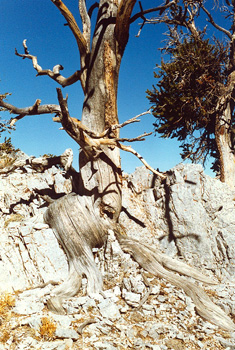
Although as a young man I knew nothing about this tree/fungal association and doubt that I had ever really considered the functional aspects of a tree's roots, I learned about their tenacity the year I was confronted by an old cottonwood stump on a ranch in northwestern Colorado, where I worked as a ranch hand. This particular cottonwood stump was in a small grove of its kind along the little stream that supplied water to the main ranch house. I forget the reason now, but the old rancher wanted the stump taken out, and removing it fell on my shoulders.
"Well," I thought to myself with the surety of youth, "this will be easy. All I have to do is chop through its roots with my ax, and I can pull it out with a team of horses." That's what I thought until the first day I hacked unceremoniously at the stump and the blade of my ax got so deeply buried in the soft wood that I couldn't get it out no matter how hard I tried.
The upshot is that I had to dig out each root on which I then cut, hacked, and sawed. In addition to my physical assault on its roots, I muttered at that infernal stump for the better part of the summer and autumn until the day came when I thought that I could in fact pull it out with a team of workhorses.
With the team hitched and anchored securely to the stump by a chain, I gave the word and the horses began to pull. I had, over the course of time, dug so far under the stump that I thought it would snap out in a twinkling. The old stump groaned and shivered, rose and fell until the chain broke, but would not release its grip in the soil. It had, I found, a monstrous taproot, which I could see only when the horses were pulling on the stump. I therefore had to dig the hole deeper.
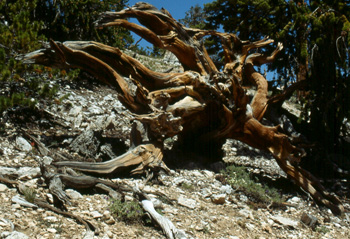
Then came the day in early October when the old stump finally relinquished its hold, and the horses pulled it free of the soil. That was a bittersweet moment because it wasn't just a stump anymore; it had become a stump with a personality. I had unknowingly developed an honest-to-goodness relationship with it, one that challenged not only me but also technology and a team of powerful horses.
But I don't think I really ever conquered it, because I have long had the distinct feeling that at some point in our relationship the old cottonwood stump decided, for whatever reason, to let me cut it out. That stump, perhaps more than any other, caused me to focus on roots. Yet as I chopped at the old stump's roots, I had no inkling of how vitally important tree roots are to the health of the forest beyond the individual trees.
Decomposing woody roots of tree stumps have distinct functions. Tree roots contribute to the shear strength of the soil, which is a root's ability to hold soil in place. Declining shear strength of decomposing woody roots increases mass soil movement after such disturbances as catastrophic fire and clear-cut logging.
Another related function of decomposing tree stumps and roots is the frequent formation of interconnected, surface-to-bedrock channels that rapidly drain water from heavy rains and melting snow. The collapse and plugging of these channels as roots decay may force more water to drain through the soil matrix, which reduces soil cohesion and increases hydraulic pressure, which in turn may cause mass soil movement. Because these plumbing systems are necessary to the stability and sustainable productivity of the soil in a forest and cannot be replaced by young trees with their relatively small roots, grandparent trees are necessary to mediate the relationship between water and soil.
Although the pear and apple trees in my garden hardly qualify as a forest, their roots perform similar functions in the soil, many of which I know nothing about. What I do know, however, is that the care I take of my fruit trees aboveground affects directly the health of their roots belowground. In addition, how I choose to participate with the aboveground environment of my garden is a choice, my choice and nothing more. But the consequences of my choices will in many unknown and hidden ways affect not only the trees but also the next person to call this small piece of ground "my garden."
Mark Collins, of the World Conservation Monitoring Center, says that "forest destruction is the key threat to species worldwide," including ten percent of the world's species of trees. One-tenth of the known species of trees in the world are in danger of extinction, yet fewer than one in four species benefit from any kind of protection, according to the 650-page report World List of Threatened Trees.
According to the study, which was financed by the Dutch government and released in Geneva, Switzerland, on August 25, 1998, 8,753 of the world's estimated 80,000 to 100,000 species of trees are vulnerable. Of these, 1,000 are classified as critically endangered, reduced to less than 100 living individuals. Some of the species threatened with extinction have yet to be investigated scientifically. What will society lose with these secret extinctions?
It is my hope that whoever reads these words will pause for a moment before putting his or her saw or ax to a tree and in that moment pay homage to the being whose life is about to be severed. I say this because it is through the consciousness with which we act, and not the acts themselves, that we honor the Creation of which we are all an inseparable part.

Smaller plants may feed and sustain us, but in trees we see ourselves.
Thomas Campanella
REFERENCES
G. William Fiero. 1988. Nevada's Valley of Fire. KC Publications, Las Vegas, NV. 48 pp.
P.J. Spielmann. 1994. Jurassic pine tree found living in a 'lost world' near Sydney. The Associated Press. In: Corvallis Gazette-Times, Corvallis, OR. December 15.
Chris Maser and James R. Sedell. 1994. From the forest to the sea: The ecology of wood in streams, rivers, estuaries, and oceans. St. Lucie Press, Delray Beach, FL. 200 pp.
Sir Charles Lyell. 1866. Principles of geology; or the modern changes of the Earth and its inhabitants. D. Appleton & Co., New York, NY. 834 pp.
Louise H. Emmons. 1989. Tropical rain forests: why they have so many species, and how we may lose this biodiversity without cutting a single tree. Orion 8:8-14.
The Associated Press. 1998. 10 percent of tree species under threat of extinction. Corvallis Gazette-Times, Corvallis, OR. August 26.
This essay is excerpted from my 1999 book "Ecological Diversity in Sustainable Development: The Vital and Forgotten Dimension."
He plants the tree to serve another age. — Cicero
©chris maser 2007. All rights reserved.
